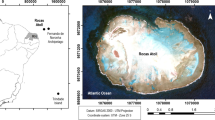Abstract
This paper analyzes interannual variations in the bioluminescence field intensity in nearshore relatively deep outside waters and in an enclosed shallow-water bay from 2009 to 2014; it presents analytical expressions of the interannual trends and reveals the 1.4- to 2.7-time decrease in the interannual bioluminescence field intensity over the studied period.
Similar content being viewed by others
References
Bityukov, E.P., Bioluminescence of Noctiluca miliaris under different temperature conditions, Biol. Morya, 1971, vol. 24, pp. 70–77.
Bityukov, E.P., Rybasov, V.P., and Shaida, V.G., Annual changes in bioluminescence field intensity in the neritic zone of the Black Sea, Okeanologiya, 1967, vol. 7, no. 6, pp. 1089–1099.
Gevorgiz, N.S., Kondrat’ev, S.I., Lyashenko, S.V., et al., The results of monitoring of the hydrochemical structure of the Sevastopol Bay in the warm season of the year, in Ekologicheskaya bezopasnost’ pribrezhnoi i shel’fovoi zon i kompleksnoe ispol’zovanie resursov shel’fa (Environmental Safety of Coastal and Shelf Zones and Complex Use of Shelf Resources), Sevastopol: EKOSIGidrofizika, 2002, no. 1 (6), pp. 139–156.
Gitel’zon, I.I., Levin, L.A., Utyushev, R.N., et al., Biolyuminestsentsiya v okeane (Bioluminescence in the Ocean), St. Petersburg: Gidrometeoizdat, 1992.
Dolotov, V.V., Kondrat’ev, S.I., and Lyashenko, S.V., Intraannual (seasonal) changes in the total content of biogenic elements and oxygen in different parts of the Sevastopol Bay, in Ekologicheskaya bezopasnost’ pribrezhnoi i shel’fovoi zon i kompleksnoe ispol’zovanie resursov shel’fa (Environmental Safety of Coastal and Shelf Zones and Complex Use of Shelf Resources), Sevastopol: EKOSI-Gidrofizika, 2005, no. 12, pp. 167–176.
Evstigneev, P.V. and Evstigneev, V.P., Spontaneous bioluminescence of Noctiluca scintillans sur. (Dinophyta), Algologiya, 2005, vol. 15, no. 3, pp. 271–279.
Mashukova, O.V., The daily rhythm of light emission of the Black Sea invader comb jelly Beroe ovata Mayer, 1912 (Ctenophora: Beroida), Ekol. Morya, 2009, no. 79, pp. 15–20.
Mel’nikova, E.B., The spatial variability of the intensity of the bioluminescence field in coastal waters of the Crimean Peninsula in the spring period, Inland Water Biol., 2016, vol. 9, no. 2, pp. 135–141. doi 10.1134/S1995082916010120
Repetin, L.N., Gordina, A.D., Pavlova, E.V., et al., The influence of oceanographic factors on the ecosystem of the semi-closed anthropogenically loaded Sevastopol Bay, Morsk. Gidrofiz. Zh., 2003, vol. 2, pp. 66–80.
Rokitskii, P.F., Osnovy variatsionnoi statistiki dlya biologov (Fundamentals of Variation Statistics for Biologists), Minsk: Izd. Belorus. Gos. Univ., 1961.
Senicheva, M.I., Annual changes in the phytoplankton community in the area of the Sevastopol oceanarium, Ekol. Morya, 2000, no. 53, pp. 15–19.
Senicheva, M.I., Species diversity and seasonal and interannual variability in plankton algae off the coast of the Crimea, in Mikrovodorosli Chernogo morya: problemy sokhraneniya bioraznoobraziya i biotekhnologicheskogo ispol’zovaniya (Microalgae of the Black Sea: Problems of Biodiversity Conservation and Biotechnological Use), Sevastopol: EKOSI-Gidrofizika, 2008, pp. 5–17.
Tokarev, Yu.N., Bityukov, E.P., Vasilenko, V.I., et al., Species diversity of planktonic bioluminescent organisms in the Black Sea and the characteristics of the bioluminescence field formed by them in the neritic zone of the Crimea, in Sovremennoe sostoyanie bioraznoobraziya pribrezhnykh vod Kryma (chernomorskii sektor) (The Current State of Biodiversity of the Coastal Waters of the Crimea (the Black Sea Sector)), Sevastopol: EKOSI MGI NAN Ukrainy, 2003, pp. 121–151.
Haddock, S.H.D., Moline, M.A., and Case, J.F., Bioluminescence in the sea, Annu. Rev. Mar. Sci., 2010, vol. 2, pp. 443–493.
Mel’nikova, Ye.B. and Liamina, N.V., Vertical distribution of biolumunescence field intensity in water of the black sea in autumn, Hydrobiol. J., 2015, vol. 51, no. 4, pp. 3–11.
Mel’nikova, Ye.B., Tokarev, Yu.N., and Burmistrova, N.V., Regularities of changes of the bioluminescence field in the black sea coastal waters, Hydrobiol. J., 2013, vol. 49, no. 3, pp. 105–111.
Tokarev, Yu.N. and Mel’nikova, Ye.B., On the issue of effect of hydrophysical parameters on intensity of bioluminescence field in the black sea, Hydrobiol. J., 2012, vol. 48, no. 4, pp. 93–99.
Ward, W.W. and Seliger, H.H., Properties of mnemiopsin and berovin, calcium activated photoproteins from the ctenophores Mnemiopsis sp. and Beroe ovata, Biochemistry, 1974, vol. 13, pp. 1500–1509.
Author information
Authors and Affiliations
Corresponding author
Additional information
Original Russian Text © E.B. Melnikova, 2018, published in Biologiya Vnutrennykh Vod, 2018, No. 3.
Rights and permissions
About this article
Cite this article
Melnikova, E.B. Interannual Variability in Bioluminescence Field Intensity in Nearshore Waters of the Black Sea. Inland Water Biol 11, 286–291 (2018). https://doi.org/10.1134/S199508291802013X
Received:
Published:
Issue Date:
DOI: https://doi.org/10.1134/S199508291802013X




